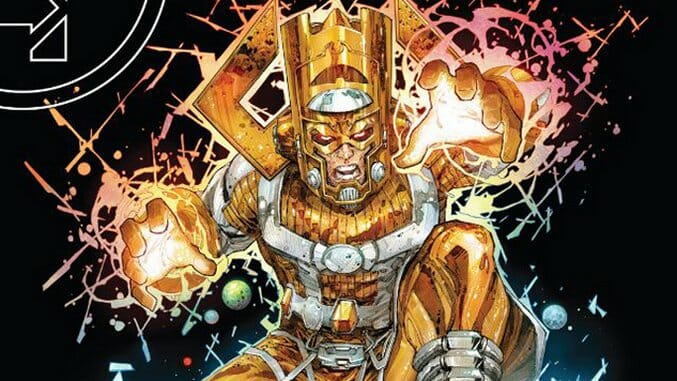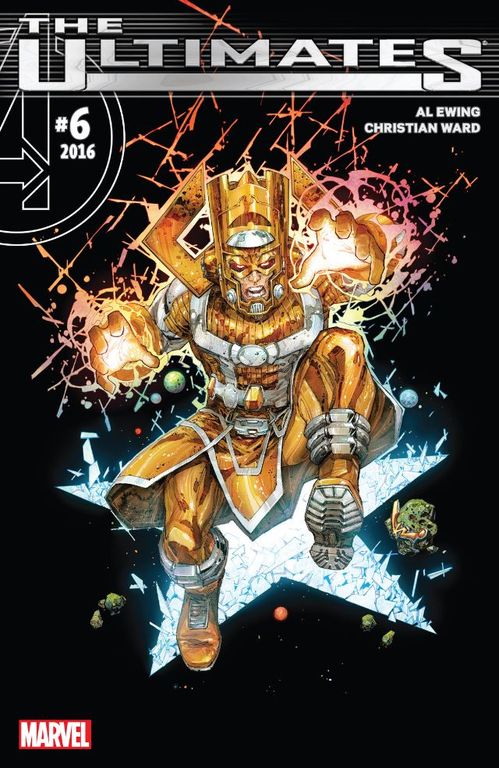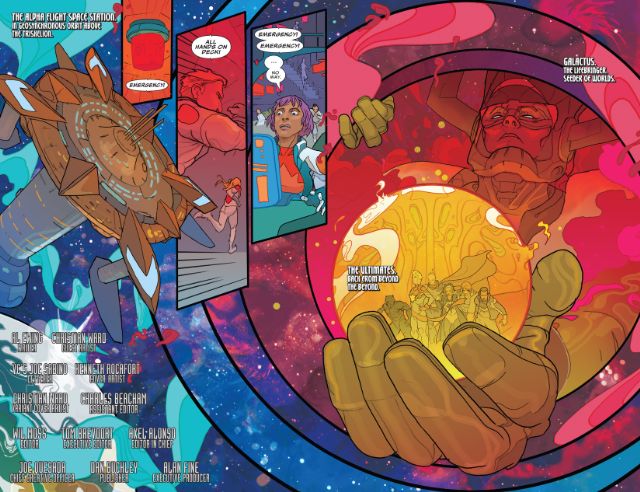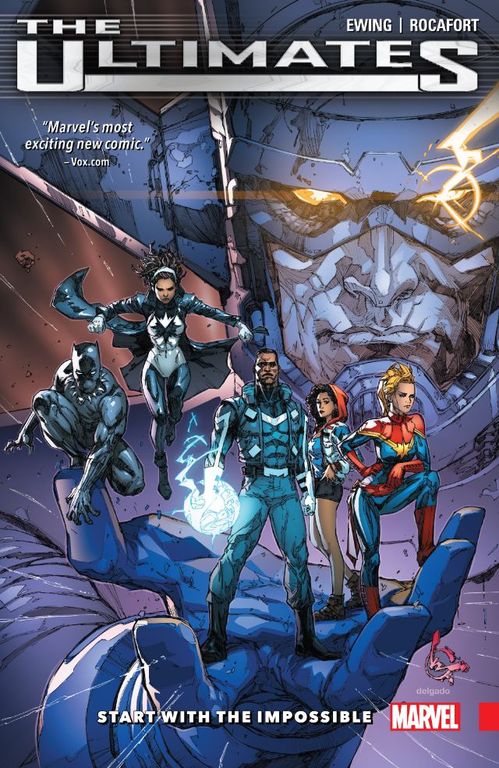Why Aren’t You Reading The Ultimates by Al Ewing & Kenneth Rocafort?
Cover Art by Kenneth Rocafort Comics Features
The first appearance of Galactus back in 1966 is one of the most revered debuts in comic book history. The massive purple planet-eater brought a cosmic grandeur and existential threat to superhero comics that had never been seen before. Sadly, diminishing returns were a problem almost immediately. By Galactus’ second appearance—just two years later—his antlers were a little less shiny, and the threat a little more routine. Sure, there have been a few great Galactus stories over the years, like when John Byrne had the Fantastic Four save Galactus’ life. But one of the best Galactus stories ever has been unfolding in Marvel’s new version of The Ultimates. For this story and more, you should be reading a thinky, diverse superhero comic by writer Al Ewing, artist Kenneth Rocafort and colorist Dan Brown.
Without spoiling the story completely, it involves a novel approach to the big guy and his omnipresent hunger: instead of trying to kill him, the Ultimates decide to fix him, realizing he didn’t spend enough time in his “birth chamber.” After the first two issues—which were far more eventful than most “events”—Galactus is yellow instead of purple, giving life instead of death. Pulling this off took all the talents of a team with a distinct set of talents. Adam Brashear—Blue Marvel—fulfills the Mr. Fantastic role as scientist/team leader. Captain Marvel (Carol Danvers) brings a military sensibility and intergalactic focus as Ambassador Extraordinary for humanity. Spectrum (Monica Rambeau, a former Captain Marvel herself) brings a long superhero resume that’s reflected in dry lines like, “Astral hunter-killer drones spat out by a giant ectoplasmic space-head? Sure. Whatever. Let me know when the real weirdness starts.” Black Panther, as ruler of Wakanda, is the most politically involved member of the group, bulldozing the Secretary-General of the United Nations in the first issue.
Ms. America (America Chavez), though the youngest, might have the broadest perspective. As a “paramedic for the multiverse,” she’s seen it all. When the team looks for Galactus’ lost incubator, Chavev can predict its location based on its landing point in “nine realities out of ten.” That kind of knowledge is useful for a team that’s trying to live up to its name by solving the “ultimate problems,” such as world-chomping demigods and twisted timestreams.

The Ultimates #6 Cover Art by Kenneth Rocafort
These Ultimates don’t have much to do with the original Ultimates team, a continuity-lite Avengers refresh introduced by writer Mark Millar and artist Bryan Hitch in 2002, other than using the name and hanging out in their government HQ, the Triskelion. They’re more indebted to another Hitch-illustrated comic: The Authority. Ewing’s narrative approach on this series is reminiscent of that series’ writer, Warren Ellis: all the characters are smart, and the pseudo-science is compelling rather than contrived. Just as Authority leader Jenny Sparks—the electricity-spewing, chain-smoking spirit of the 20th century—was prone to making reassuring (and sometimes scolding) remarks to the Earth populace over a reality-spanning loudspeaker, the Ultimates keep the world abreast of their activities, including borderline insane missions, no matter how incomprehensible or insane they sound. In fact, Ewing makes these announcements serve double duty—as the first page of each issue, they’re also recaps.
Those announcements have an in-story purpose that references another Marvel team: the Illuminati, who the Ultimates explicitly do not want to be. That team of secretive heroes (including Reed Richards, Dr. Strange, Iron Man, Black Panther, Namor, Professor X and Black Bolt) lived down to their creepy name by going behind the backs of the world and their friends, usually making everything worse. The Ultimates’ fear of becoming Illimuniti-ish is justified, cleverly embodied by the private, unannounced logs that take up progressively more space on each recap page, vying for page room with the upstanding public communiques. This is a neat commentary on the fact that nobody in power, no matter how well-intentioned, is going to tell everyone everything, and maybe they shouldn’t. It’s one thing for Brashear, “We’re fixing the timestream.” It’s another to add, “Oh, by the way, I bumped into the guy who killed my wife on this all-important mission, and my personal issues almost jeopardized reality on a fundamental level.” That could be awkward.

Ultimates #6 Interior Art by Christian Ward
Rocafort’s art is consistently inventive, conveying space-time kerfuffles via panel compositions that are fractured and inventive in a way similar to ACO’s remarkable work on Steve Orlando’s Midnighter run. Rocafort’s work would make Jack Kirby proud, not because it utilizes some of Kirby’s ideas but because it takes them to new places. Colorist Dan Brown is a perfect tag team partner for Rocafort, giving depth and a feeling of awe to Rocafort’s images. The best bit of art might be in issue three, when the team travels through a star-shaped hole in the omniverse so they can look at the timestream from the outside. Rocafort and Brown convey a sense of weirdness that’s not just Kirby-esque but Steve Ditko-esque too, recalling the trippiness of dimension-hopping Dr. Strange.
This is also a series that is extremely—and casually—diverse. Publishers trumpet diversity in comics loudly these days, often in a somewhat sensationalist way. “A woman is holding the hammer of Thor!” “Iron Man is a female black teenager!” Unfortunately, such changes tend to be holding patterns until the original white, male hero returns. The Ultimates include no white males, but this isn’t a plot point or even a marketing angle, though maybe it should be. The matter-of-fact manner in which the team tries to solve problems is mirrored by the creative team’s presentation of diversity, which is only highlighted when a member of the U.S. National Security Council describes the team as looking “like a damn Benetton ad.”

The Ultimates #1 Cover Art by Kenneth Rocafort
Even the fill-in issue—with artist Christian Ward of ODY-C fame subbing for Rocafort—couldn’t slow down the series’ momentum, as the focus shifted to Galactus trying to figure out why Eternity (the embodiment of the Marvel cosmos) is in chains. This issue gets even more colorfully cosmic than usual as Galactus debates and battles embodiments of Chaos and Order while playing the role of hard-boiled, long-antlered cosmic detective. It’s been a theme of Galactus stories since the beginning that the big purple guy isn’t evil and has an important purpose in the universe, but he’s hardly ever been shown pursuing anything other than his next meal. This new spin on Galactus continues to be a highlight of a consistently surprising series that, just as Galactus is now re-enlivening dead worlds, is making long-dead concepts feel full of potential.
The Ultimates has dealt with the dreaded fill-in issue with style, but it remains to be seen if it can survive a larger challenge: the event tie-in. Recent issues are linked to what’s shaping up as a dog’s breakfast of an event, Civil War II. It would be ironic if the Ultimates were able to fix Galactus and save Eternity but fell victim to the mundane reality of the obligatory crossover.
Mark Peters is the author of Bullshit: A Lexicon. Follow him on Twitter.
